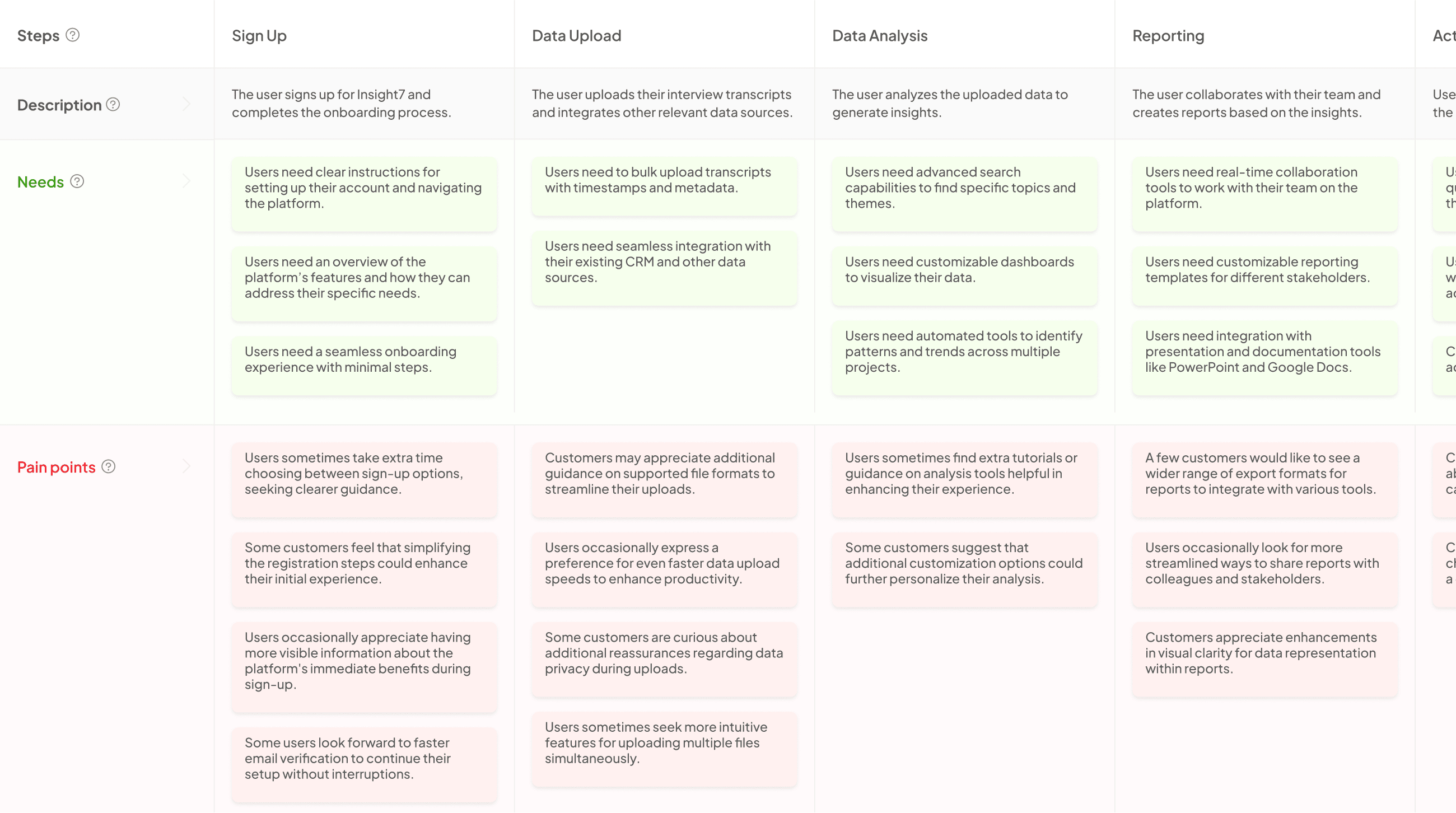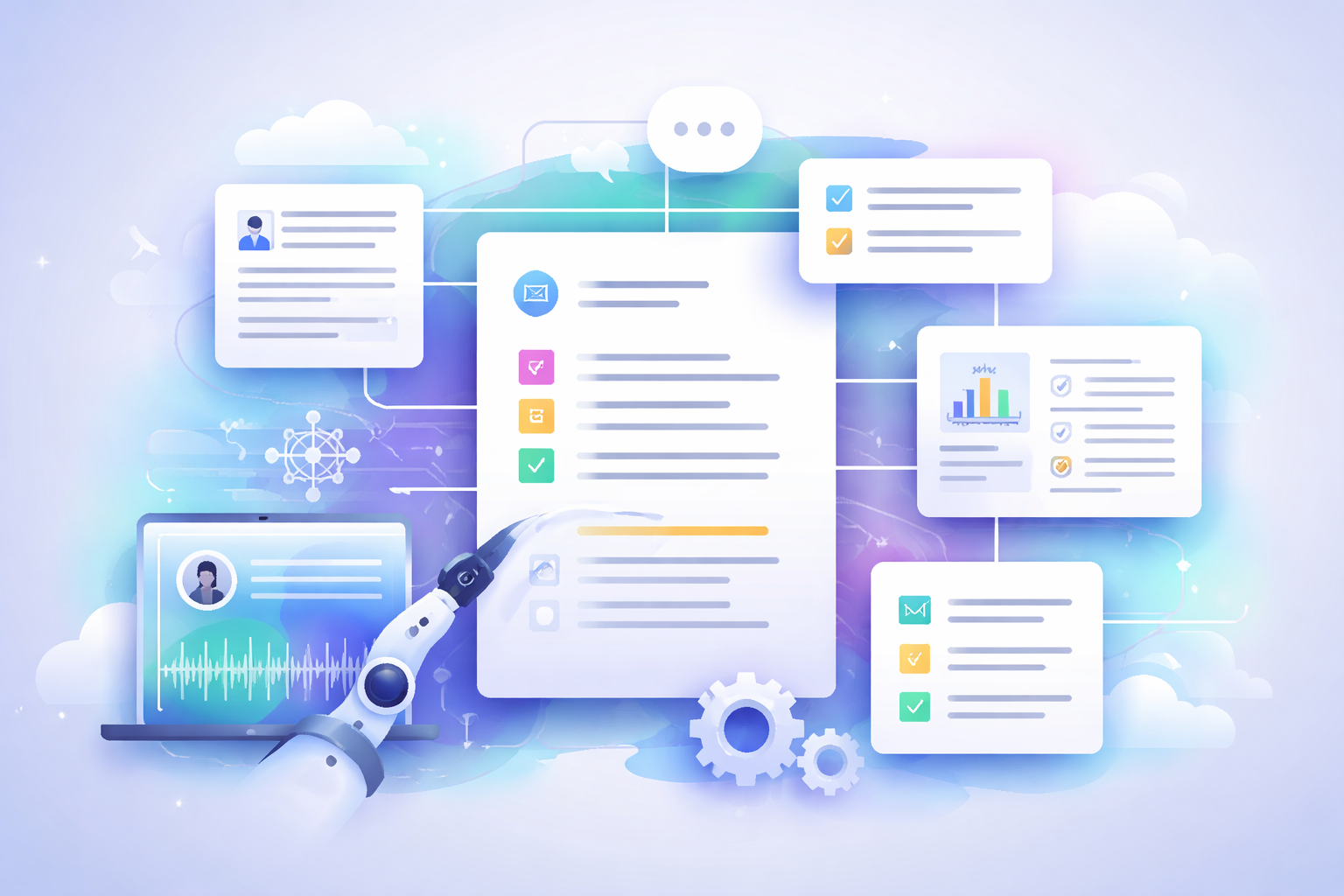Best AI tools for generating journey maps from prospect interviews
-
Bella Williams
- 10 min read
In an increasingly data-driven world, understanding your prospects' journey is crucial for effective decision-making. AI Journey Mapping revolutionizes how businesses analyze prospect interviews by offering actionable insights through advanced data analysis. This modern approach enables organizations to transform unstructured data from interviews into coherent journey maps, identifying key pain points and opportunities that may otherwise go unnoticed.
Employing AI in this context not only streamlines the analysis process but also enhances accuracy and depth of insights. By uncovering trends and patterns from vast amounts of conversation data, businesses can better align their strategies with customer needs. As organizations embrace AI Journey Mapping, they unlock the potential for more meaningful connections with their audience, ultimately driving growth and innovation.
Extract insights from Customer & Employee Interviews. At Scale.

The Role of AI in Journey Mapping
AI Journey Mapping is revolutionizing how businesses analyze customer experiences during prospect interactions. By utilizing advanced algorithms and data analysis techniques, AI streamlines the process of gathering insights from interviews. This technology allows organizations to visualize customer journeys, identifying pain points and preferences at every stage, from initial research to final decision-making.
The AI journey mapping process involves several key steps. First, it captures data from customer interviews, transcribing and organizing feedback efficiently. Next, AI tools analyze interactions, providing detailed visualizations that highlight user emotions and experiences. Finally, actionable insights emerge, enabling businesses to understand customer needs better and enhance their offerings. By integrating AI into journey mapping, companies can make informed decisions, elevating customer satisfaction and overall business success.
Understanding AI Journey Mapping
AI Journey Mapping serves as a vital tool for businesses looking to refine their understanding of customer experiences based on insights gathered from prospect interviews. This process involves transforming raw data from conversations into visual representations that outline the entire customer journey. By mapping the steps customers take—from initial research to making decisions about purchases—companies can uncover critical friction points that impact customer satisfaction and engagement.
Using AI in this mapping process enhances the ability to analyze vast amounts of data efficiently. This analytical power allows for more accurate identification of customer needs and pain points, leading to improved recommendations and strategies. By investing in AI Journey Mapping, businesses can make data-driven decisions that enhance their service offerings, ultimately leading to a richer customer experience and increased loyalty. This understanding is essential for any organization aiming to remain competitive and responsive in today's dynamic market.
Benefits of AI Journey Mapping for Businesses
AI Journey Mapping provides businesses with critical insights into their customer experience. By visualizing the customer journey, companies can pinpoint friction points that affect user satisfaction. Understanding these pain points allows organizations to make informed decisions that improve the overall experience for their clients.
One major benefit of AI Journey Mapping is the efficiency it brings to data analysis. AI tools can quickly process large amounts of data from prospect interviews, highlighting trends and insights that human analysts might miss. Additionally, these maps can serve as valuable tools for team alignment, ensuring that all departments have a consistent understanding of the customer experience. By prioritizing customer needs and addressing challenges, businesses not only enhance customer satisfaction but also drive loyalty and retention. Embracing AI Journey Mapping ultimately leads to actionable strategies that can result in sustainable growth and a competitive edge in the market.
Generate Journey maps, Mind maps, Bar charts and more from your data in Minutes
Top AI Tools for AI Journey Mapping from Prospect Interviews
AI Journey Mapping offers a powerful avenue for organizations to translate insights gathered from prospect interviews into meaningful customer experiences. By utilizing specialized AI tools, businesses can effectively analyze conversations and visualize customer journeys in a more streamlined manner. This process not only enhances understanding of customer needs but also identifies friction points that may hinder user satisfaction.
Several top-tier AI tools can aid in this transformation. First, Insight7 stands out for its user-friendly interface, allowing anyone to effortlessly access customer insights without specialized training. Next, Narrative Science automates the analysis and storytelling of data, helping teams comprehend complex information with ease. Smaply provides mapping functionalities to visualize the customer journey effectively, while UXPressia adds value with its ability to create user personas and journey maps seamlessly. Lastly, Reframer focuses on synthesizing qualitative data, offering teams the insights needed to refine customer interactions. Each tool plays a vital role in enhancing AI Journey Mapping from prospect interviews, ultimately driving improved business outcomes.
Leading Tool: Insight7
Insight7 stands out as a leading tool in the realm of AI Journey Mapping, designed to tackle the complexities of analyzing customer interviews. This intuitive, self-service platform enables users to sift through vast amounts of interview data with ease, allowing insights to be distilled quickly and effectively. Many businesses face challenges when managing and interpreting customer conversations, often feeling overwhelmed by the scale of data generated. Insight7 provides a solution, transforming these scattered insights into coherent narratives that drive strategic decisions.
Using Insight7, companies can identify patterns in customer feedback and translate these findings into actionable strategies. The tool facilitates collaboration among team members by centralizing insights, thus fostering better communication and faster implementation of changes. In a competitive landscape, those who efficiently leverage insights gained from AI Journey Mapping, like those offered by Insight7, will be the ones to advance ahead of the curve.
Tool Breakdown: Narrative Science
Narrative Science stands out as an exceptional tool for AI Journey Mapping, transforming raw data from prospect interviews into actionable insights. This user-friendly platform allows team members, regardless of technical expertise, to access vital information effortlessly. It democratizes data usage by enabling users to generate meaningful reports, transcribe conversations, and understand the overall customer experience.
Key to its function is the capability to analyze individual calls and aggregate insights across projects. The platform extracts pain points, desires, and behavioral patterns, presenting them in digestible formats. Users can discover recurring themes or specific customer quotes that describe their experiences, making it easier to identify friction points and improve overall engagement. This streamlined process is crucial for any business looking to utilize AI Journey Mapping effectively, ensuring that valuable customer insights guide strategic decisions and drive improvements.
Tool Breakdown: Smaply
Smaply stands out as a robust tool for AI journey mapping, expertly combining user-centered design with comprehensive analysis. This tool allows organizations to visualize customer journeys, making it easier to understand how customers interact with their brand. By collecting data from prospect interviews, businesses can create detailed journey maps that reveal pain points and opportunities for improvement.
The tool offers several unique features that enhance the journey mapping process. First, it facilitates collaborative design, enabling teams to gather insights collectively. Second, Smaply allows users to create personas based on rich insights, helping to tailor strategies to specific audience segments. Lastly, its integration with other data sources ensures that the journey maps remain dynamic and reflective of ongoing customer experiences. As businesses strive to create impactful customer journeys, Smaply proves to be an invaluable asset in the realm of AI journey mapping.
Tool Breakdown: UXPressia
UXPressia stands out as a dynamic tool for AI journey mapping, designed to transform insights from prospect interviews into visual journey maps. This platform allows users to easily organize and analyze user feedback, making it accessible for everyone in the company, regardless of their technical expertise. With a user-friendly interface, teams can start capturing valuable insights right from the homepage without extensive training or preparation.
One of the key features of UXPressia is its capability to synthesize data from multiple user interactions, enabling businesses to visualize customer experiences comprehensively. Users can transcribe conversations and extract essential insights, such as pain points and desires, presented in an intuitive format. This functionality ensures that organizations can quickly identify patterns, address customer needs effectively, and build cohesive journey maps that enhance understanding of the user experience. Ultimately, utilizing UXPressia simplifies the journey mapping process while helping teams make data-driven decisions.
Tool Breakdown: Reframer
Reframer is a powerful tool designed to enhance AI journey mapping by simplifying the analysis and transformation of data from prospect interviews. It empowers users to quickly transcribe and evaluate recorded conversations, offering a more intuitive approach to extracting insights. This innovative platform provides customizable templates for various evaluation types, facilitating compliance checks or quality assurance assessments consistent with your specific organizational needs.
Users can seamlessly load calls and generate transcripts, making it easy to identify key themes or quotes. Additionally, the tool’s structured evaluation criteria allow for a comprehensive analysis of customer interactions. By focusing on core metrics such as problem identification and customer education, Reframer provides detailed reports that illuminate the customer journey, making it easier to visualize pain points and opportunities for improvement. This capability is essential for businesses looking to refine their customer engagement strategies and enhance overall user experience.
Conclusion: The Future of AI Journey Mapping and Its Impact on Business
The future of AI journey mapping is poised to transform how businesses understand their customers. By harnessing advanced AI tools, companies can generate detailed journey maps from prospect interviews, revealing critical insights about customer experiences. This shift will enable businesses to identify and address pain points, enhance user interactions, and streamline decision-making processes.
As AI journey mapping evolves, it will become essential for organizations striving for competitive advantage. Embracing these innovations not only improves customer satisfaction but also drives strategic growth. Companies that leverage AI journey mapping will be better equipped to anticipate customer needs and create tailored solutions, strengthening their market position and fostering enduring relationships with clients.







